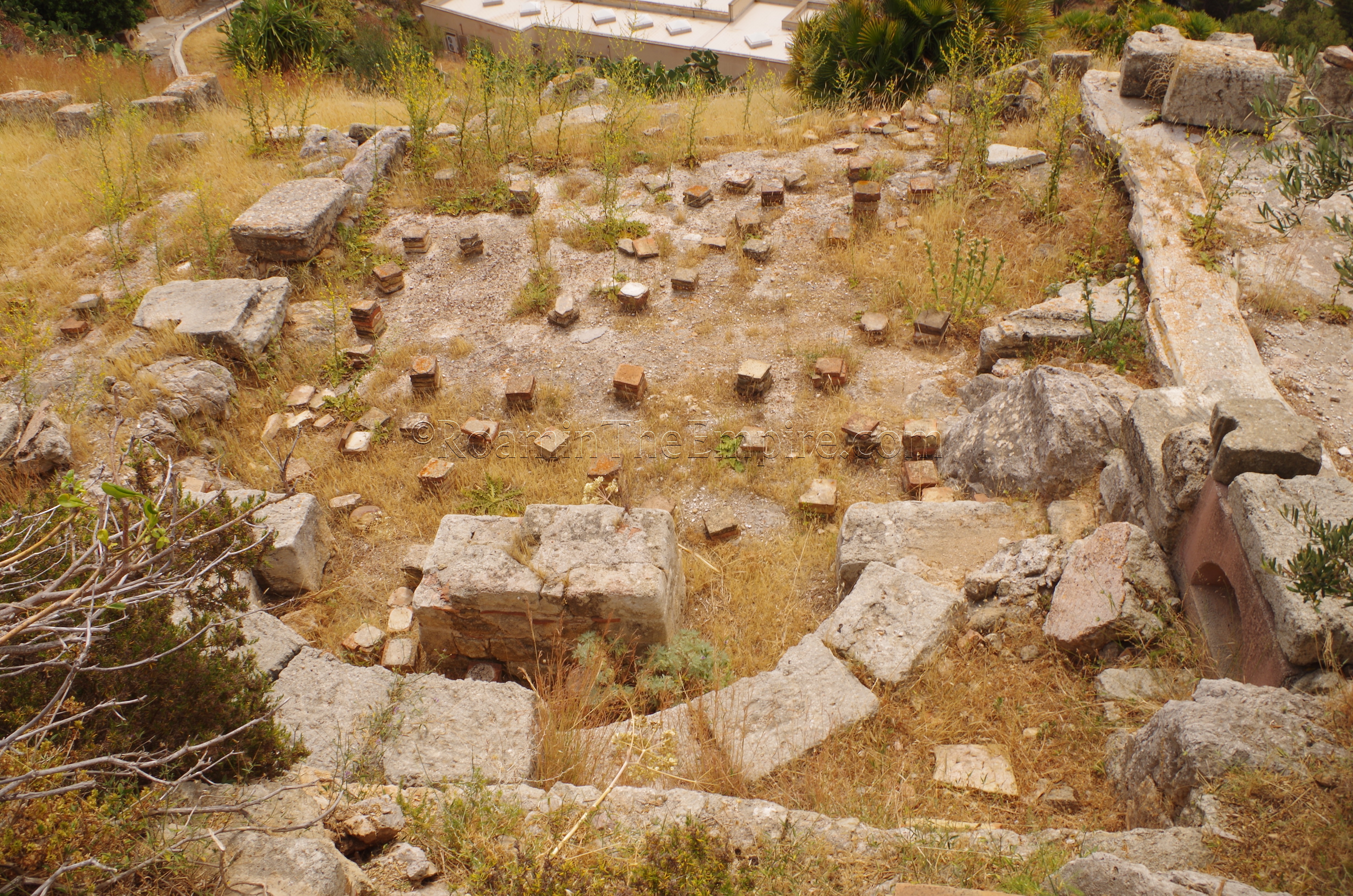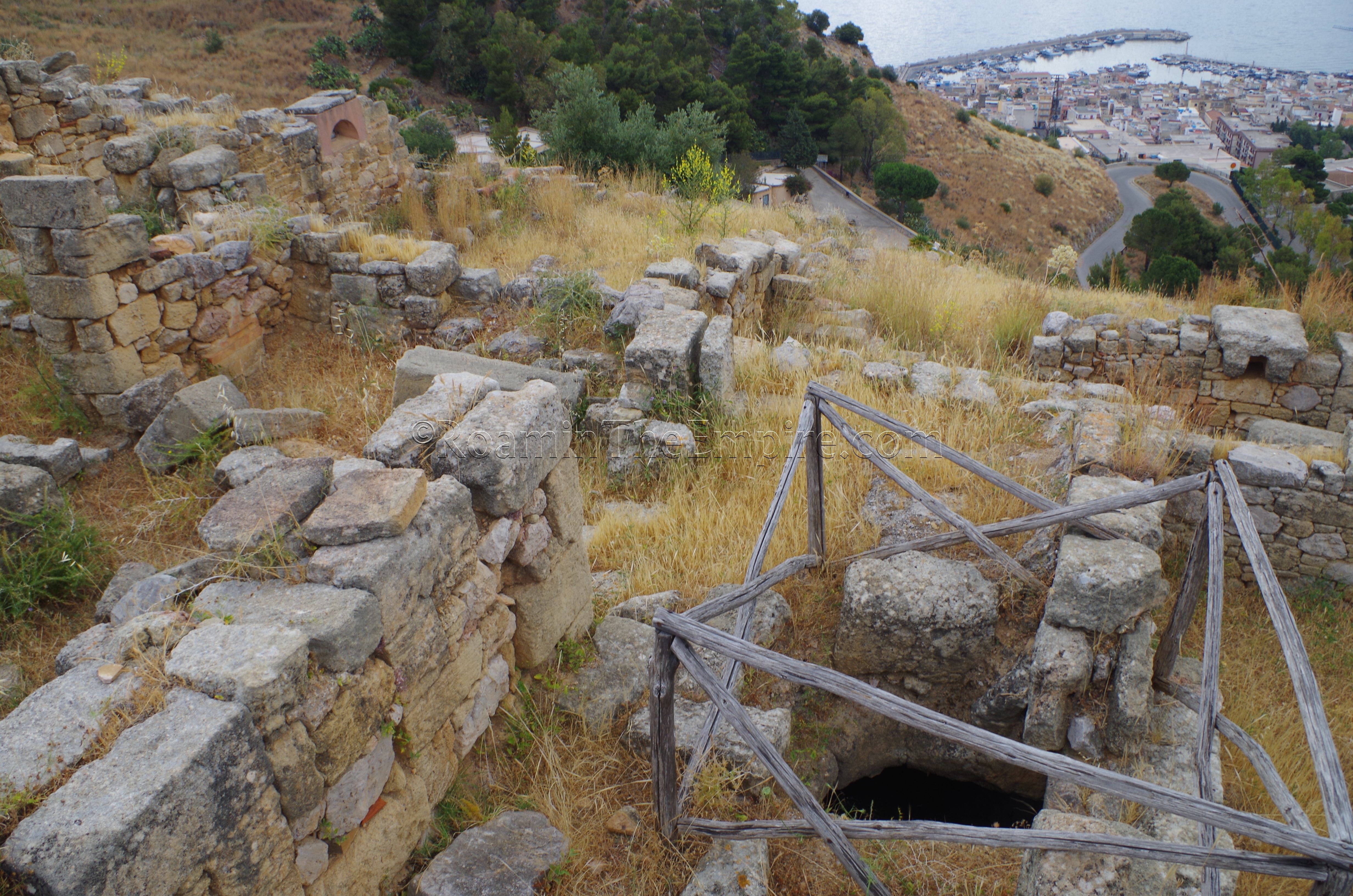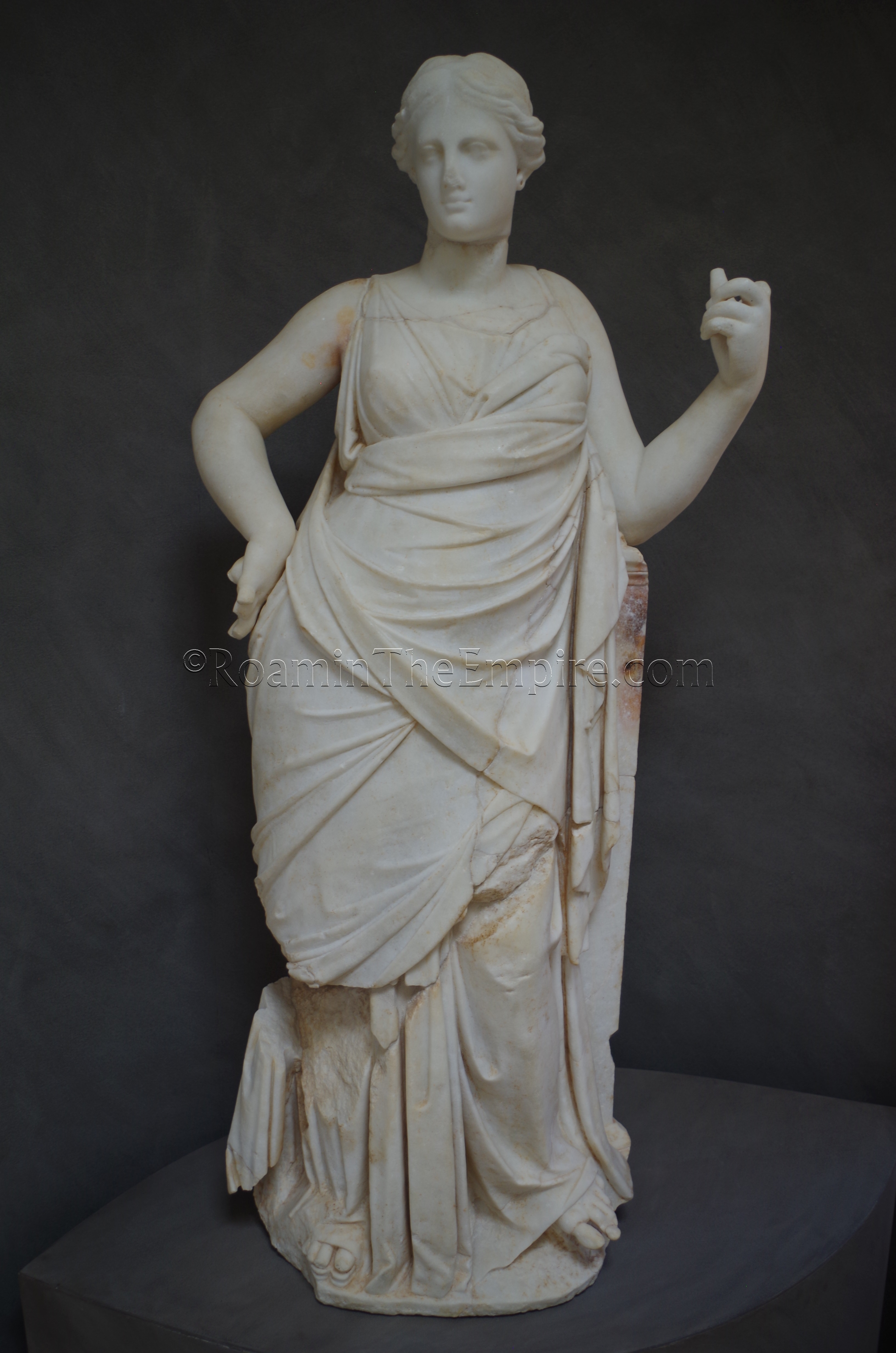
Most Recent Visit: June 2017.
Located about 15 kilometers west of Palermo, on a low plateau of Monte Catalfano, are the remains of the town of Soluntum (also called Solus or Soloeis during Punic control). Like nearby Panormus and Motya, Soluntum seems to have been founded by Phoenician traders prior to the end of the 8th century BCE, as it is mentioned by Thucydides as one of the three settlements to which the Phoenicians fell back to during Greek expansion toward the western part of the island around that time. As such, it also would have been the easternmost bastions of Punic presence on the island at the time. As was the case with the other Phoenician settlements on the island, as the Phoenicians in the Near East came under foreign dominion, the towns became increasingly reliant on the Carthaginians and fell into their influence as their power grew in the region. Soluntum doesn’t get many mentions in the historical record during the early portions of the Sicilian Wars between the Carthaginians and Greeks, but, given its proximity to Panormus, it likely follows the trajectory that city did in the early conflict.
When Motya was destroyed by Dionysius of Syracuse in 397 BCE, Soluntum is mentioned as one of the cities that stayed loyal to the Carthaginians, along with Segesta, Panormus, Entella, and Halicyae. While Segesta and Entella were actively besieged by Dionysius, the tyrant was satisfied to plunder the surroundings of Soluntum without actually putting the city to siege, at least initially. In 396 BCE, however, the city was sacked by Dionysius, apparently given up by treachery, though the exact nature of how the city was captured and destroyed is not mentioned. Given that the city was largely destroyed in this episode, it is unclear if the area stayed under the control of the Greeks until the end of the conflict or not, but, by 341 BCE, when the Carthaginians and Greeks signed a peace treaty, the area was back under the control of the Carthaginians.

Whether or not a new city had actually been constructed by 307 BCE is unclear, but at that time, following the conclusion of Carthage’s conflict with Agathocles of Syracuse from 315 BCE to 307 BCE, a number of mercenaries that were abandoned in Africa by Agathocles after his campaign there were resettled at Soluntum by the Carthaginians. Agathocles suffered a defeat in 307 BCE, precipitating the peace treaty that ended the conflict, and he fled back to Sicily, leaving most of his army behind, at the mercy of the Carthaginians. There is no mention of Soluntum’s fate during the Pyrrhic Expedition to the island, though it presumably came under the control of Pyrrhus during the conflict, as all the Carthaginian holdings on the island save for Lilybaeum were reportedly conquered. Like the rest of the Carthaginian cities Pyrrhus captured, though, it quickly passed back to the Carthaginians after his exit from the island.

At the outbreak of the First Punic War between Carthage and Rome, before major hostilities commenced between the two powers, Hannibal’s son, Hanno, advanced from Lilybaeum to Soluntum in order to reinforce the town and left a force there. When Panormus was captured by the Romans in 254 BCE, Soluntum, along with a number of other towns in the area that were loyal to the Carthaginians, expelled their Punic garrisons and handed the settlements over to the Romans. Soluntum remained under the control of the Romans until the end of the war, when it, along with all the other Carthaginian settlements on the island, were permanently occupied by the Romans. Soluntum doesn’t seem to have been occupied or threatened by the Carthaginians during their brief expedition on Sicily during the Second Punic War.
Under the Romans, Soluntum was one of the civitates decumanae on Sicily that paid a tax of one tenth of their agricultural production to Rome. Cicero notes that Soluntum was among the settlements of Sicily that were abused by the actions of Verres. The settlement seems to have been reasonably prosperous in the following years, though of little overall importance in the grand scheme of things. This isn’t altogether surprising given its proximity to Panormus, which became a major administrative and commercial center on the island. Coins from the reign of Commodus seem to be the latest finds at the site, indicating that Soluntum probably had experienced some level of decline in the years leading up to that point and was likely abandoned about that time or perhaps sometime in the next century or so.
Getting There: The modern name for the site and area is Solunto, and the archaeological area is not especially convenient to get to, even by car, and less so by public transportation. By personal vehicle, getting to the site via the E90 from Palermo is a pretty convoluted affair, as the nearest exit that doesn’t require going through the city of Bagheria is at Casteldaccia, and the only exit is to the south, which means one basically has to turn around in the town, which proved a lot easier said than done, even with GPS and a map. Though the route is a bit slower, it seems like it would be much easier and straightforward to take the SS113 out of Palermo. In either case, both routes are signed to some degree, though, they do require a bit of intuition and some general knowledge on where you’re headed. By public transport, the closest train stop is Santa Flavia-Solunto-Porticello, about 2 kilometers away. Keep in mind, though, about a third to a half of that would be an uphill walk. Trains leave from Palermo once and hour (currently at 49 minutes past the hour between 7:49 and 17:49, and intermittently before and after) and take about 20 minutes to get there. The price one way is 2.50 Euro. The return trip is similarly about once an hour, but on a little more irregular of a departure schedule. To get to the site from the train station is pretty easy; head right out of the train station (north) take the first right (east) and travel over the train tracks, walk about 230 meters and take the 2nd left (north) onto SP59, and basically take that all the way up to the site.
The Area Archeologica di Solunto is located at Via Collegio Romano, 90017 Solunto, Santa Flavia, PA. The site is open Tuesday through Saturday from 9:30 to 16:00 and on Sundays and holidays from 9:30 to 14:00. Admission is 4 Euros for the site and the on-site museum.
What remains of the settlement today is exposed on a (relatively) gentle slope above the modern town of Porticello. Nearly all of what remains in the archaeological park dates to the town built following the 396 BCE destruction and is referred to as the Hellenistic-Roman town; the Punic-era town is down along the coast in the area of the modern-day town of Solunto. Despite the fact that much of the decoration, and the style of some buildings (such as many Hellenistic-Roman style atrium houses), is distinctly Hellenistic or Roman, some elements of the town also have a Punic form to them as well. This is particularly reflected in some religious structures, particularly the open-air Punic style altar in the area of the city where much of the civic architecture is. This mixture likely reflects the varied influences working on the new town towards the end of the 4th century BCE, when it was a technically Carthaginian town populated by Greek mercenaries, that came under Roman dominion shortly after. Punic small finds were also found in the Hellenistic-Roman town.

A small antiquarium is located at the entrance of the site where admission is purchased. Previously the museum for the site, it offers a small glimpse at the city and helps to put some things in context. From there, an original road leading to the town in antiquity is taken up to the excavated portion of the settlement. The first set of remains encountered are those of a bathing complex that is dated to the 1st century BCE. The presence of mosaics in the frigidarium that are dated to the 1st century CE, though, attest to a renovation done at that time.

Most of what remains at Soluntum is domestic architecture of various styles. The insula adjacent to the bathing complex at the start of the site, across the road to the northwest, are houses without peristyles. The houses here, also with a more elongated plan in comparison to Greco-Roman houses, are generally interpreted as being Punic in style, similar to 4th-3rd century BCE houses found at Carthage and Kerkouane. It’s also surmised that these smaller houses were also inhabited by those of a lower class than those inhabiting the larger terraced housing that makes up much of the rest of the domestic dwellings excavated at Soluntum.

Due to the slope of the site, the larger houses are often spread over multiple terraces. In many of them, there are the vestiges of mosaics, and even some more well-preserved mosaics in others. Some also retain some of the wall plaster and decoration. Some rooms with wall painting, such as in the House of Leda, or mosaics are covered, but, in many cases the remains don’t seem to have warranted the special attention, but are worth seeing nonetheless. As previously mention, these houses are typically more identifiable as the Greco-Roman style of houses built around an atrium, but, due to the necessity for terraces, the overall plan is a bit altered and sometimes not as easily to discern as houses that are built on level ground.

The slope of the site also had an effect on the usage and management of water at Soluntum. Cisterns in the private dwellings of the city are relatively plentiful, as the location on the top of a hill likely made fresh water sources fairly scarce, and there doesn’t seem to be any indication of any large-scale water transport to the location. The cisterns then would have been fairly important in securing a water source for the city. In addition to the personal cisterns in the houses, there was also a large 24 x 8 meter cistern at the northeast end of the site where much of the other public architecture is. An interesting aspect is one of the water collection systems used a sort of small dam to divert water that would have been cascading down the sloped streets off into channels that carried it into cisterns along the cardo maximus of the city.

The north end of the city includes most of the public and religious architecture that is excavated at Soluntum. The previously mentioned Punic open-air altar and associated sacred area is here as well as the large cistern. Other buildings include a stoa and agora, theater, gymnasium, and bouleuterion/odeon. Both the theater and the bouleuterion are in rather rough shape, but, can be seen for the most part. Much of this area seems to have been constructed during a large rebuilding project in the 2nd century BCE. The theater, carved into the hillside in the Greek style, had 22 rows of seats and could seat about 1,500-1,600 spectators. The sign for the bouleuterion notes a capacity of about 1,200, but, given the size disparity between the two structures, one of those estimates seems to be a bit off.

Perched at the northern/northeastern most point of the city, overlooking Capo Zafferano, is the largest dwelling excavated so far in the city, the House of the Garlands. Though still sloped somewhat, the grade of the slope here is much lower than the rest of the site. The owners of the House of the Garlands seemingly had some degree of status in the city. The remains of mosaics and wall paintings in the Third Pompeian Style can be seen, though access to the house is restricted and it can only be viewed from the decumanus passing between it and the gymnasium. The insula of houses above the theater/public buildings is identified as an artisan district.
The site here is quite large, it took me two hours to walk through it, and while I did walk through most of the houses and see just about everything here, at least in passing, I certainly could have spent a bit longer, perhaps a half an hour to an hour longer. Since much of the city is on a slope, there is a fair amount of uphill walking to see many of the houses, though the cardo maximus runs relatively level across the site after the initial climb to the site. It still wasn’t quite tourist season when I visited, so, many parts of the site were a bit overgrown, and I presume there would have been some landscaping done later in the season to rectify this, as seems to be the case with many sites. There are signs posted at the major houses and other structures of interest in both Italian and English, though some of the signs are in rough shape and can be a bit difficult to read.

Exit from the site is through the newer museum adjacent to the antiquarium. There are some interesting finds displayed in the museum; fragments of stucco decoration, wall painting, and various other architectural elements. There are various other small finds including pieces of statuary, altars, and reliefs. Most of the more important finds, however, are evidently at the archaeological museum in Palermo (and incidentally not on display during the renovation). One particularly nice piece as a small statue of a Muse found in the House of Leda. The museum is relatively small and only takes about 20-30 minutes to go through, especially if you aren’t fluent in Italian and can’t really read the plentiful informational posters throughout. Though the posters are in Italian only, most of the individual artifact cards also have English translations.
Sources:
Diodorus, Bibliotheca Historica, 14.48, 14.78, 20.69, 23.1, 23.18.
Holloway, R. Ross. Archaeology of Ancient Sicily. Routledge, 1991.
Smith, Christopher John. Sicily from Aeneas to Augustus: New Approaches in Archaeology and History. Edinburgh Univ. Press, 2007.
Stillwell, Richard, William L. MacDonald, and Marian Holland. McAllister. The Princeton Encyclopedia of Classical Sites. Princeton, NJ: Princeton U Press, 1976.


